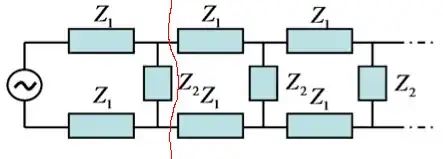A recent question asked how to find the impedance of an infinite chain of series-plus-parallel circuits. The standard trick is to split the chain after the first link, and treat the tail of the circuit as a copy of the original, bigger circuit. That is, the circuit contains a copy of itself, which is fine as it is infinitely long.

The corresponding equation for the circuit's impedance $Z$ is then
$$ Z=2Z_1+\frac{1}{\frac{1}{Z_2}+\frac{1}{Z}}, $$ which gives an easy quadratic equation in $Z$ with solutions $$ Z=Z_1\left[1\pm\sqrt{1+2Z_2/Z_1}\right]. $$
Now, for purely resistive $Z_1$ and $Z_2$ it is clear enough which sign the square root should have, since then $\sqrt{1+2Z_2/Z_1}>1$ and the minus sign is ruled out by the condition that $\mathrm{Re}(Z)\geq 0$ (unless one is OK with free energy coming out of nowhere).
However, this need not be the case. An easy example is where $Z_1=1/i\omega C$ is capacitive and $Z_2=i\omega L$ is inductive, in which case $$ 1+2Z_2/Z_1=1-2\omega^2 LC $$ can, depending on $\omega$, be smaller than one, giving two distinct possible values for $Z$. This result will hold if both impedances have small but nonzero resistive components, which is a more physical situation. An infinite chain of coupled oscillators has all the makings of a wave line, but that does not mean that the impedance of the line can suddenly have two different values.
How does one resolve this? What are the conditions on $Z_1$ and $Z_2$ for this to be a problem? How does this relate to the continuum limit on the transmission line?